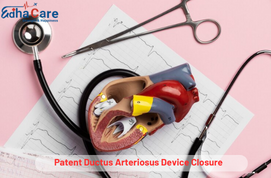Patent Ductus Arteriosus Device Closure

A minimally invasive procedure termed the patent ductus arteriosus (PDA) device closing is used for correcting the congenital cardiac abnormality known as patent ductus arteriosus. This disorder causes the ductus arteriosus, the blood vessel that is supposed to close down soon after being born, to stay open, causing irregular flow of blood between the lung artery and the heart's aorta. PDA device closure entails directing a catheter to the heart by putting it into a blood artery, usually in the groin. The open ductus arteriosus is then closed off with a specialized device, like a coil or plug, to allow normal blood flow to return. Surgery on the heart isn't necessary because the procedure is carried out under local anesthesia with supervision provided by fluoroscopic technology. When compared to surgical closure, PDA device closure has a lower risk of complications, is generally safe and successful, and requires less recovery time. It is frequently done in order to avoid consequences including infective endocarditis, pulmonary hypertension, and heart failure in newborns, kids, and adults with symptomatic or big PDA.
Book an AppointmentAbout Patent Ductus Arteriosus Device Closure
Patent Ductus Arteriosus Device Closure Symptoms: Rather than managing symptoms directly, the patent ductus arteriosus (PDA) device closure treats a congenital cardiac abnormality. However, intervention may be needed in response to signs of an open ductus arteriosus. Heart murmurs, fast breathing, and increased heart rate are common signs. Poor feeding, insufficient weight gain, and heightened vulnerability to respiratory infections can also arise in babies. In severe circumstances, some people may have signs of heart failure, exhaustion, or trouble breathing. If any of these signs are present, it is imperative that you get evaluated by a medical professional right away because immediate treatment and diagnosis can reduce complications while improving outcomes. For people with symptoms or large PDAs, PDA device closure is typically suggested in order to avoid problems and return heart function to normal.
Patent Ductus Arteriosus Device Closure Causes : Since patent ductus arteriosus (PDA) is a hereditary cardiac defect that develops during fetal development, the causes of PDA device closure are unconnected to the condition's actual growth. The ductus arteriosus, the blood vessel that connects the aorta with the pulmonary arteries, abnormally persists after delivery. The procedure is instead carried out to address the effects of PDA. This persistence may result in irregular blood flow between the heart's main arteries, which could manifest in symptoms including fast breathing, poor feeding, and cardiac murmurs in babies. PDA device closure involves inserting a catheter-based device—such as a coil or plug—to close the open ductus arteriosus in order to repair the aberrant flow of blood.
Patent Ductus Arteriosus Device Closure Remedies : Rather than immediately treating symptoms, patent ductus arteriosus (PDA) device closing is a corrective procedure designed to correct a congenital cardiac abnormality. The ductus arteriosus, the blood conduit that links the aorta and pulmonary arteries, can remain open after birth in PDA, a medical condition that can cause irregular flow of blood and symptoms like heart murmuring and fast breathing. In order to close the arteriosus patent and restore regular flow of blood, a catheter is inserted into a blood vessel, guided to the heart, and a device is deployed to seal it off. In order to avoid complications and guarantee effective management, it is crucial that people with symptoms or large PDAs receive a quick evaluation by a medical professional, even if the operation targets the underlying cause of PDA.
Procedure of Patent Ductus Arteriosus Device Closure
The following steps are involved in the final closure of a patent ductus arteriosus Device Closure Procedure (PDA):
Preoperative Assessment: To assess candidacy for device closure and to identify the size and location of the PDA, the patient is put through an extensive evaluation which involves an overview of their medical records, a physical exam, and diagnostic procedures such as an echocardiography and a cardiac catheterization.
Anesthesia: To ensure that the patient is unconscious and without discomfort throughout the surgery, general anesthesia is administered.
Access: A small groin incision is made, and a tube called a catheter is introduced into a vessel that supplies blood, typically the vein or femoral artery.
Guidewire Placement: To put the guidewire close to the PDA, it must be advanced through a catheter and directed to the heart under fluoroscopic guidance.
Device Deployment: A coil or plug, or similar particular closure device, is inserted through the tube and placed at the PDA site. The device is put in place to close off the PDA and stop aberrant flow of blood between the aorta and the pulmonary arteries after it has been properly positioned.
Confirmation: To ensure proper PDA closure and consistent blood flow, imaging techniques including fluoroscopy and echocardiography are utilized to check the device's placement and stability.
Closure: The catheter is taken out and gentle pressure is administered to the groin area to stop the bleeding once the PDA has been confirmed to have closed successfully. After that, adhesive strips or sutures are used to close the incision.
For the purpose of to guarantee stability and identify any issues, postoperative care usually involves maintaining an eye on the patient's condition for a few hours. After surgery, the majority of patients are able to return to their regular activities in a few days. Appointments for regular check-ups are scheduled in order to evaluate the success of the device closing and keep an eye out for potential issues. PDA device closure, taken as a whole, is a less intrusive and effective therapy option for shutting PDAs and restoring heart function to normal.
Require Assistance?
Get A Quick Callback From Our Healthcare Experts






